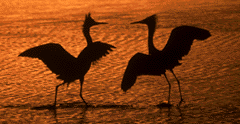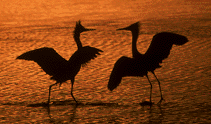Just how good are the new Canon Image Stabilizer
Super-telephoto lenses?
In late September, I got my hands on the prototype 600mm f/4.0L Image
Stabilizer lens and had the opportunity to field test it for 3 weeks. To
say the least, I was most impressed. With its lighter weight
(11.8125 pounds) and shorter minimum focusing distance (18 feet), I would
have--as a full time working professional--purchased this lens even without the
remarkable new tripod-sensing image stabilizer technology. In addition, the lens
is reported to be the fastest focusing 600mm autofocus lens ever manufactured,
by anyone. My brain, however, cannot measure micro-seconds, but I
absolutely loved the lens.
Another plus: manual (mechanical) prefocusing is
available at all times. If, for example, you are using the lens with the
2x (where the light lost to the multiplier increases the time of initial
focusing acquisition tremendously), you can simply focus manually (even when in
AI Servo mode) until the subject is in relatively sharp focus and
then activate AF and let it
take over. Nine out of ten times, focus acquisition will be
instantaneous.
As for the IS technology, I truly believe that the new IS super-telephotos
will blow the socks off the photographic world, and will most likely put Nikon
years behind yet again. After shooting more than 60 rolls of film with the
tripod-mounted lens with the IS feature turned on (the
lens manual incorrectly advises that IS be turned off
when the lens is mounted on a tripod), I was amazed that I had made many
sharp images of birds with the 2X tele-extender at shutter speeds as
slow as 1/90 of a second, and some sharp images with
the 1.4X teleconverter at shutter speeds as slow as 1/30 of a
second, the latter something that I was never able to do with the
original 600 f/4.0L lens. By using the new Fuji film, Provia F, and
pushing it one stop, the 1200mm focal length (600mm plus 2X TC) becomes a viable
bird photography set-up in most lighting conditions.
Astounding. Then, I made a series of huge-in-the-frame (full) moon shots
with stacked multipliers (the 2X on the lens and the 1.4X on the camera
separated by a 12mm extension tube). They were sharper by far than similar
images produced with the old 600. In fact, they were amazingly
sharp.
I have not yet had a chance to see how the IS technology works in
conjunction with mirror lock and very slow shutter speeds, but look
forward to doing so at Bosque Del Apache NWR in NM early this
winter.
As much as I love the lens, there were two minor problems:
1-With the
lens designed with the tripod mount too far to the rear of the lens, the rig is
front heavy so that rotating the lens barrel from horizontal to vertical
(or visa versa) in the tripod collar is a bit difficult. (The weight of the
front of the lens causes increased friction between the lens barrel and the
tripod mount.) With the old 600, you simply loosened the locking
button and easily and quickly rotated the lens barrel by rotating the
camera with your right hand. With
the IS version, the lens barrel rotates more easily if you lift up the
front of the lens with your left hand while rotating the lens barrel while
holding the camera body with your right hand. This arrangement slows
you down a half-second, but in nature and sports photography, a
half-second can seem like a lifetime.
2-The manual focusing ring was a bit too stiff for my taste.
As for the other new lenses in the series, I am sure
that they are all wonderful additions to the Canon lens lineup, but the IS
benefit for bird photographers will most likely be greatest in the 600mm and the
500mm focal lengths. (I plan on purchasing the 500mm IS (approximately four
pounds lighter than the 600 IS) early next year; this lens should prove deadly
when used with the 2X TC.) Sports photographers--who usually work on
monopods--will quickly embrace this new family of lenses and white lenses will
once again dominate the sidelines at major sporting events around the
globe. And lots of wildlife photographers are walking around with big
smiles on their faces and sharper images on their lightboxes.
Since my initial evaluation, I have been using the 600
IS almost every day and am even more impressed with the lens than I was.
Images made with the 600 IS/2X TC combination continue to amaze me.
Additionally, I have begun using stacked multipliers for photographing some
small birds and the results have been equally amazing. If I ever get my
scanner out of its box and get my huge, new computer hooked up, I will post some
of these new images on my web site.
LENS CLEANING TIPS
From Bryan Geyer at Really Right Stuff: Stop buying lens cleaning
tissue. Buy rolled absorbent cotton instead. It cleans the front
element of your lens like a charm and leaves no residue.
I've gone a
step further: I save and use the cotton from my supplement bottles. From
Moose Peterson: Use Lens Clens # 1 Coated Optics (Industrial Optical Cleaner)
for cleaning all your equipment, including the front elements of all your lenses
(telephone: 714-535-2271). I bought the pint bottle which will most likely
last a lifetime as I clean my stuff less in a year than Moose does in an
evening..... I keep the 1 3/4 oz. refillable bottle in my vest with a few chunks
of absorbent cotton. Be sure to use a blower brush to remove any
sand, dirt, or grit before using the Lens Clens and the cotton. Use one wet
chunk of cotton to clean the lens and then a dry one to polish the front
element. (Moose cleans the surfaces of all his lenses and camera bodies
and accessories as well as the front elements of his lenses with an old,
soft, cotton t-shirt each night.) 

